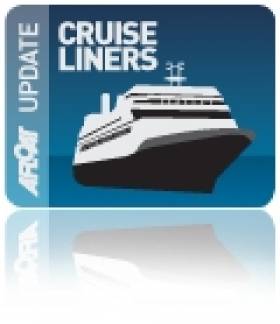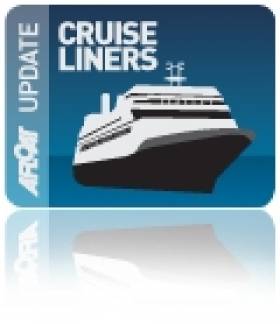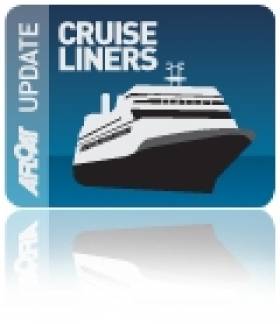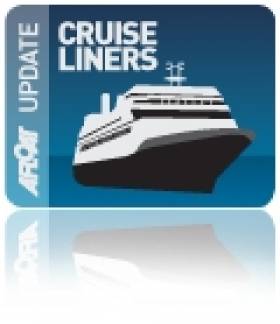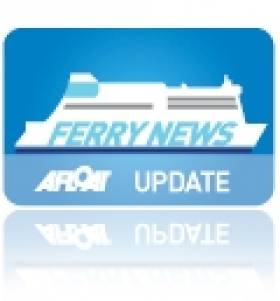Displaying items by tag: Dun Laoghaire CruiseBerth
#CruiseLiners - Plans for large scale cruise ships to be accommodated in Dun Laoghaire Harbour are back on the agenda after Bord Pleanála relisted the application on Wednesday writes The Irish Times.
The original planning application to accommodate cruise ships of up to 340 metres long, at a berth stretching 435 metres into the harbour, will now be reassessed by the planning board.
Last November, Bord Pleanála granted planning permission for the cruise ship proposal but restricted the size of ship which could facilitated, to 250 metres long.
This permission was challenged by the campaign group Save Our Seafront in a judicial review before the High Court.
The group, which is an environmental non-governmental organisation chaired by local People Before Profit TD Richard Boyd Barrett, claimed that the environmental effect of the proposed cruise berths were not adequately assessed by the Board.
For more on this story click here.
Management of Dún Laoghaire-Rathdown Resist Cruiseship Limits
#CruiseshipLimit - The Irish Times reports that Dún Laoghaire-Rathdown councillors move to limit the size of cruise ships allowed to berth in Dún Laoghaire harbour – effectively banning “supersized” cruise ships – has been opposed by council management.
Members of the local authority voted two-to-one last December to ban cruise ships in excess of 250m long in the local authority’s drafting of the county development plan.
However, in a management response to submissions on the plan the authority’s chief executive Philomena Poole said the ban should be deleted.
Ms Poole’s comments were circulated to councillors on Tuesday. Councillors will get a final vote on whether to include the ban when the development plan is adopted, expected to be in February.
While the management report on the councillors’ proposed prohibition notes a large number of submissions in favour of the proposal, Ms Poole said the harbour was already a protected structure and does not need the additional protection of the ban.
The chief executive’s opposition is significant as Dún Laoghaire Harbour Company has applied to An Bord Pleanála for permission for a cruise berth facility of almost 400m and significant dredging inside and outside the harbour walls.
To read more and about the transfer of the harbour to local authority control in accordance to the Harbours Bill, please click here.
Decision Delayed on New Dún Laoghaire Cruise Berth
#CruiseBerth - A final decision may take months on a planned new cruise berth in Dun Laoghaire Harbour is reached, after An Bord Pleanála deferred announcing its ruling on the project, writes The Irish Times.
It had been expected that the planning authority would announce its decision to either grant or deny permission for the development in Dún Laoghaire Harbour by January 8th.
However, a spokesman for the board said an announcement may not be made until after the new target date of April 15th next. The spokesman confirmed that An Bord Pleanála had not reached a decision on the controversial proposal within the initial 18-week timeframe set by the board.
While the authority may reach a final decision on the project prior to April 15th, this is not guaranteed.
An oral hearing, which spanned almost a month in total, was said to have contributed to the delay.
The publication date of the decision may need to be pushed out further again if the board decides that further deliberation is needed, after its chief inspector’s report for the cruise berth is completed.
The €18 million development, spearheaded by Dún Laoghaire Harbour Company, has proven a divisive issue in the south Dublin area. The topic has also been debated in the Oireachtas.
To read more on this latest development, click here.
Oral Hearings to be Given Into Dun Laoghaire Harbour’s Proposed Cruise-Berth
#CruiseBerthHearings - At almost 100,000 tonnes Mein Schiff 4, the largest ever cruiseship to anchor so close to Dun Laoghaire Harbour yesterday, was also the same day that Afloat.ie learnt that An Bord Pleanála is to proceed with oral hearings into the planning application of the proposed yet controversial €18m cruise-berth, writes Jehan Ashmore.
An Bord Pleanála has advised that both of the oral hearings are to be begin next month. The hearings in October are been held in accordance with section 134 (I) of the Planning & Development Act 2000, in respect of the Dun Laoghaire Harbour Company’ s planning application for the cruise-berth facility.
The proposed 435m long single cruise-berth jetty, associated structures and dredging of the channel off St. Michaels Wharf and a 500m turning circle outside the harbour entrance would enable ships considerably larger than Mein Schiff 4 to dock in the harbour. The new $625m German cruiseship had anchored less than one nautial mile off the East Pier during her her maiden call to the harbour following a visit to Belfast Harbour.
Last month a deadline expired for a public consultation process on the cruise-berth project in Dun Laoghaire Harbour that led to An Bord Pleanála receiving 150 submissions.
Due to the scale and complexity of the planning application, the board of An Bord Pleanála, has decided to hold a preliminary meeting on 7 October in advance of the more substantive oral hearing to be held a week later on 14 October. This second hearing is scheduled to run for approximately 8 days over two separate timeframes within that month.
A Senior Planning Inspector has been appointed by the board of An Bord Pleanála during the oral hearings regards the submissions and observations raised in regards to the likely effects on the environment of the proposed cruise-berth. In addition, the consequences for proper planning and sustainable development in the area are to be considered, and the likely effects on a European site will also be reported to the board.
This latest development on the oral hearings reported here on Afloat.ie follows a Dun Laoghaire-Rathdown County Council meeting held earlier this week where, according to the Gazette, a request was made by local councillors for the An Bord Pleanála to conduct such hearings into the cruise berth project. A motion tabled by Cllr Victor Boylan (Ind) was held where 23 councillors were in favour of the oral hearing and 13 councillors voted against it.
Cllr Boyhan said he was “disappointed at the planning authority report drawn up by the council executive” and was therefore happy with the motion being passed to seek an oral hearing with An Bord Pleanála's planning inspector prior to a decision being made on the cruise berth.
He added: “I think it is significant that 150 people came together, and paid €50 per submission, to air their views on the proposed cruise berth plans.”
For more on the topic, click the local newspaper’s report here.
Dun Laoghaire Cruise Berth Planning Application 'Online' In Tandem with Consultation Process
#CruiseBerthConsultation – Details on all the documents in relation to the proposed Dun Laoghaire Harbour Company cruise berth planning application to An Bord Pleanala are now available from the dedicated website: www.dlcruiseplan.ie
As previously reported on Afloat.ie plans for the €18m cruise-berth are on public display. Observations / submissions can be made to An Bord Pleanála during the seven-week public consultation period which began today (9 July 2015).
A full copy of the planning application is available on the above referred website. Information contained on that website will only be available for the period of the planning application process. Full copies are also available to view or purchase with An Bord Pleanala and the Dun Laoghaire-Rathdown County Council only.
The public should raise any questions or concerns directly with the planning authorities, An Bord Pleanála. Please do not contact the DLHC directly with regard to this planning application.
To consult the DLHC proposed cruise-berth (a downloadable file) can be visited through the link here.
As reported on Inshore-Ireland, submissions or observations may be made ONLY to ABP during the seven-week consultation period, relating to:
1) implications of the proposed development for proper planning and sustainable development of the area concerned
2) likely effects on the environment of the proposed development if carried out
3) likely significant effects of the proposed development on a European site if carried out.
Submissions/observations must be accompanied by a fee of €50 and must be received by ABP not later than 5.30pm on August 27, 2015.
Among the documents that can be inspected during the public opening hours for the seven week consultation period are the Environmental Impact Statement (EIS) and Natura Impact Statement.
Alternatively, all the documents may be inspected free of charge or purchased on payment of a specified fee (which fee shall not exceed the reasonable cost of making such copy) during public opening hours for a period of 7 weeks commencing on 9 July 2015 at the following locations:
The Offices of An Bord Pleanála, 64 Marlborough Street, Dublin 1
The Offices of Dún Laoghaire Rathdown County Council, Civic Offices, County Hall, Marine Road, Dún Laoghaire, Co Dublin
#CruiseBerthPlans – The Herald writes that from today plans for a controversial jumbo cruise ship facility in Dun Laoghaire harbour will go on public view.
The Dun Laoghaire Harbour Company (DLHC) lodged (last Friday as previously reported on Afloat) a planning application for the upgrade of the harbour with An Bord Pleanala at a cost of €100,000.
Prior to lodging the application, the company held a three-week public consultation period earlier this year. It said that 139 people made submissions - the vast majority of which (104) were opposed to the plans.
However in its application to the planning authority, the DLHC has said that most of the concerns expressed by people were based on misunderstandings about the plans.
The company prepared a response to these concerns addressing the most common issues, including the perception the plans would bring no economic benefit or would negatively impact on harbour users.
In a comprehensive Environmental Impact Statement, the company proposed that there would be no major, lasting negative impact to the users or the environment of the harbour.
However it did acknowledge that the jumbo cruise ships would "have a significant impact on all existing views towards the harbour".
"A proportion of existing harbour users may consider the sheer scale of the docked ship to be negative given that the vast majority of other vessels using the harbour are small by comparison," it said.
For more on this story, click Here.
#CruiseConsultation - Gillian Mills of Inshore Ireland writes that Dún Laoghaire/Rathdown Independent Councillor, Victor Boyhan has called for an oral hearing of a planning application for a major cruise berth terminal that was lodged today (last Friday) by Dún Laoghaire Harbour Company.
The eight-year, €18m strategic infrastructure development, comprising a 435m pier with an underpass, ancillary site and landscape works, will accommodate 'next generation cruise ships', according to the Dún Laoghaire Stakeholder Group.
To qualify as an SID, a proposed development must first come within the scope of one or more of the classes outlined in the 7th Schedule to the 2000 Act, and comply with the thresholds contained therein.
In addition, the Board must come to the opinion that the proposed development, if carried out, would fall within one or more of the following:
• is of strategic economic or social importance to the State or the region in which it would be situate
• would contribute substantially to the fulfilment of any of the objectives of the National Spatial Strategy or any regional planning guidelines in respect of the area or areas in which the development would be situate
• would have a significant effect on the area of more than one planning authority
The opinion is formed by the Board at the conclusion of the pre-application stage.
Inshore Ireland has much more on the proposed cruise-berth facility and details of observations / submissions to be made to An Bord Planeala during the seven-week consultation period, click here.
Yacht Clubs in Dun Laoghaire Harbour Unite To Sink Cruise Berth
#CruiseBerthOpposition – Some of the country's most exclusive yacht clubs in Dun Laoghaire Harbour are fighting to stop proposals for a new terminal designed to facilitate "super-sized" cruise liners.
Dun Laoghaire Harbour Company displayed plans to build a 390-metre long cruise berth for passenger ships as part of a non-statutory public consultation for two weeks over Easter.
It is one of three bodies involved in the Dun Laoghaire Cruise Stakeholder Group, which is promoting the proposed facility. The other supporters are Dun Laoghaire-Rathdown county council and Dun Laoghaire Business Improvement District (BID).
The combined group will submit a planning application to An Bord Pleanala, by the end of this month.
The Royal St George Yacht Club, a 177-year-old institution with its elegant Victorian clubhouse at the harbour , has warned the proposed cruise berth would be "of megalithic proportions", would have a negative impact on local amenities and "dissect" the Victorian-built landmark.
To read more, The Sunday Times reports HERE
In addition an image supplied by Dún Laoghaire BID (Business Improvement District) Company and article as previously reported on Afloat.ie shows an artist's impression of proposed cruise-berth as viewed from high above the harbour.
#BackToFront- Dun Laoghaire Harbour Company's public consultation process over a €18m Cruise-Berth ended yesterday and came in advance of Stena Line's contract with the harbour authority that expired today, writes Jehan Ashmore.
Following the closure of public submissions on the cruise plan which drew controversary, DLHC are to lodge a finalised planning application to An Bord Pleanala. The application will be accompanied by an (EIS) Environmental Impact Statement for the proposed berth regarded as a Strategic Infrastructure.
The cruise berth capable of handling some of the world's largest cruiseships, formed part of the DLHC Masterplan adopted in 2011 and in the knowledge of the declining Stena Line ferry operations.
The plan for a new 435m jetty in the centre of the harbour with associate 300m cruise quay is to accommodate massive cruiseships that are even larger than those calling at anchorage.
This seasons first caller, notably the 333m long MSC Splendida of 137,000 tonnes is due on 11 May with 3,600 passengers and 1,300 crew. The cruiseship's crew total is 200 short of those taken on the HSS 1500 series Stena Explorer.
An announcement by the ferry operator last February that is was to withdraw operating the seasonal-only Dun Laoghaire-Holyhead route permanently in 2015.
Stena citing unsustainable losses and concentrated on their existing use of Dublin Port services to Holyhead served by last month's newcomer Superfast X alongside Stena Adventurer. The Dublin Port Company's proposed €30 cruise terminal near the East-Link bridge was unveiled recently at the Miami Exhibition, Florida.
In regards to the final HSS Stena Explorer sailing (see Ships Monthly photo) on Dun Laoghaire-Holyhead route this took place last September. A subsequent stint of sailings to cover the Festive and New Year sailings were cancelled on the historic Ireland-Wales link.
At Dun Laoghaire the specialist ro-ro-linkspan structure is exclusively designed for use of HSS Stena Explorer. As previously reported, as part of the Stena contract with DLHC there are plans underway by subsidaries of the ferry company to remove the HSS related structure from St. Michaels Wharf.
As part of the proposed cruise-berth plan, the St. Michaels Wharf ferry terminal's vehicle marshalling area are to be used for cruise-ship related traffic in the form of coaches and taxis. In addition is the construction of a boardwalk overlooking the adjoining 820-boat marina.
The HSS ferry terminal completed in the mid-1990's stands on the site of a former car-ferry terminal dating to the 1960's and is from where ferries may return. As previously reported, an invitation from DLHC was sought from suitable providers to resume the Ireland-Wales route with submissions due by February.
DLHC required that such a ferry operator would re-open the route on a seasonal-only basis, in which seven parties expressed an interest. Should such operations begin, DLHC have stated this would not be until 2016.



























